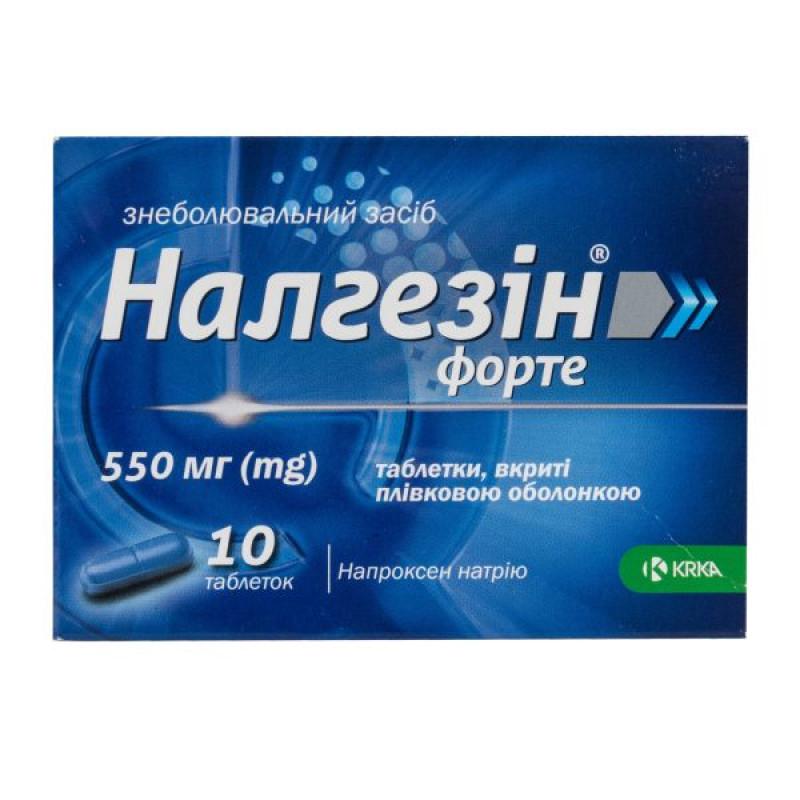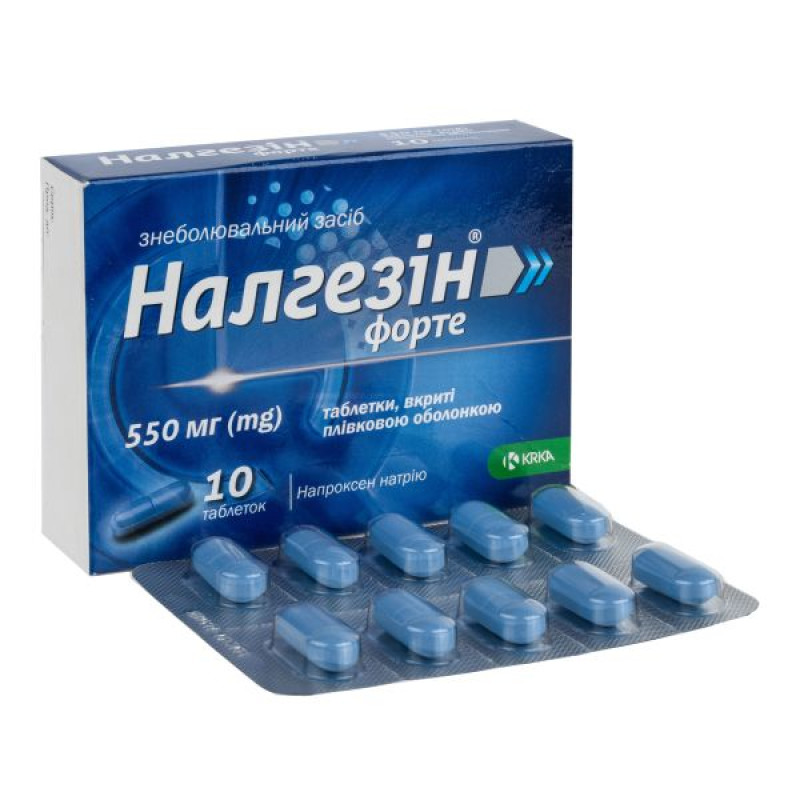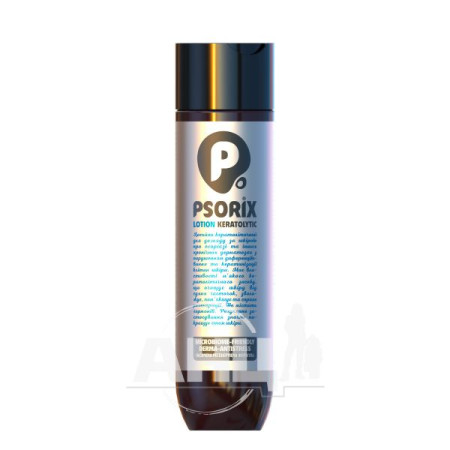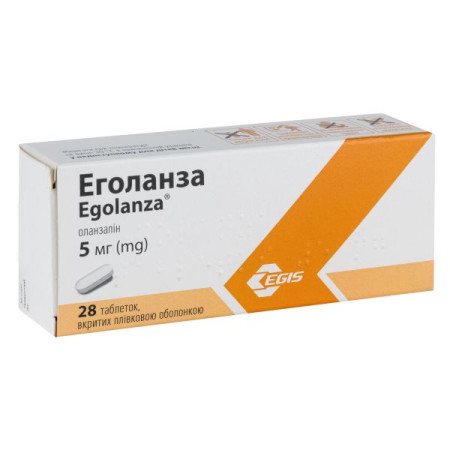Nalgesin forte film-coated tablets 550 mg No. 10
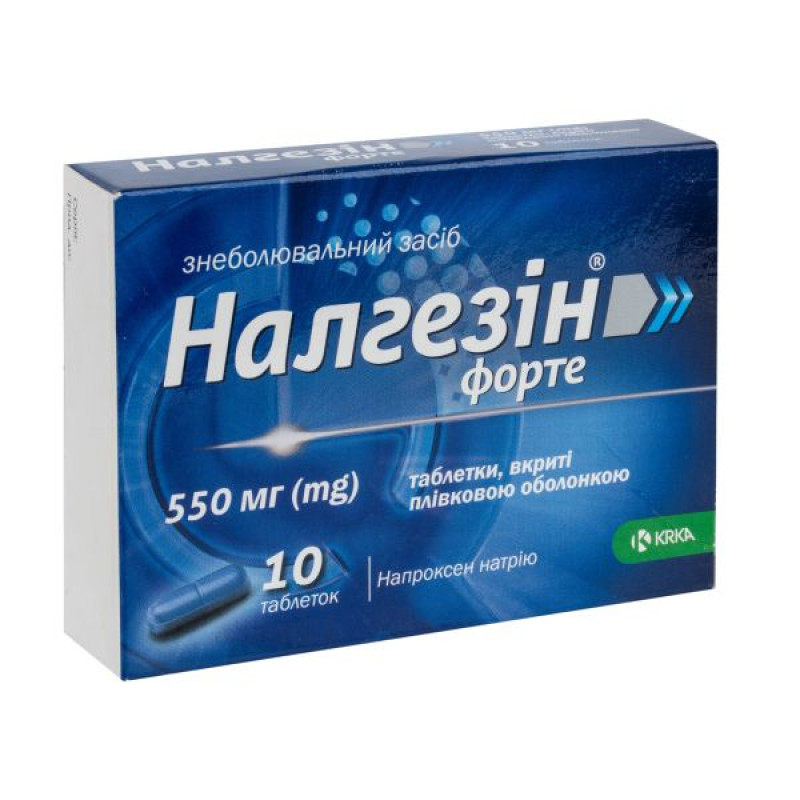
Instructions for use Nalgesin forte film-coated tablets 550 mg No. 10
Composition
active ingredient: naproxen sodium;
1 film-coated tablet contains 550 mg of naproxen sodium;
Excipients: povidone, microcrystalline cellulose, talc, magnesium stearate, hypromellose, titanium dioxide (E 171), macrogol, indigo carmine (E 132), purified water.
Dosage form
Film-coated tablets.
Main physicochemical properties: oval, film-coated tablets, blue, slightly biconvex with a score on one side.
Pharmacotherapeutic group
Nonsteroidal anti-inflammatory and antirheumatic drugs. Propionic acid derivatives. Naproxen. ATC code M01A E02.
Pharmacological properties
Pharmacodynamics.
Naproxen sodium is a nonsteroidal anti-inflammatory drug (NSAID). It has analgesic, anti-inflammatory and antipyretic effects. The mechanism of action of the drug is due to the inhibition of cyclooxygenase, an enzyme involved in the synthesis of prostaglandins. As a result, the levels of prostaglandins in various body fluids and tissues decrease.
Pharmacokinetics.
After oral administration, naproxen sodium is hydrolyzed in acidic gastric juice. The maximum plasma concentration is observed 1–2 hours after taking the drug. The concentration of naproxen in plasma increases in proportion to the increase in the dose of the drug. Approximately 99.5% of naproxen is bound to plasma albumin at drug concentrations up to 50 μg/ml. Approximately 70% of naproxen is excreted unchanged and approximately 30% as the inactive metabolite 6-dimethyl-naproxen. Approximately 95% of the drug is excreted in the urine and 5% in the feces. The biological half-life of naproxen is independent of plasma concentration and dose and is 12–15 hours.
Indication
Migraine;
toothache;
menstrual pain;
pain after injuries (sprains, bruises, overload);
pain after surgical intervention (in traumatology, orthopedics, gynecology, dentistry);
rheumatic diseases (rheumatoid arthritis, osteoarthritis, ankylosing spondylitis and gout).
Contraindication
Hypersensitivity to naproxen or to any of the excipients.
Hypersensitivity to salicylates and other NSAIDs, manifested as bronchial asthma, urticaria, rhinitis and nasal polyps.
Acute period or recurrence of gastric or duodenal ulcer, bleeding in the gastrointestinal tract (GI).
Severe liver and kidney dysfunction (creatinine clearance less than 30 ml/min).
Heart failure.
Pregnancy or breast-feeding (see section “Use during pregnancy or breast-feeding”).
Interaction with other medicinal products and other types of interactions
Concomitant use of acetylsalicylic acid and other nonsteroidal anti-inflammatory drugs is not recommended due to the high risk of adverse reactions.
Concomitant use with antacids or cholestyramine, as well as with food, may slow the absorption of naproxen, but does not affect the amount of active substance absorbed.
Concomitant use with cardiac glycosides may lead to exacerbation of heart failure, decreased glomerular filtration rate, and increased levels of cardiac glycosides in the blood.
Naproxen should not be used within 8–12 days after taking mifepristone due to its ability to reduce the effects of the latter.
Caution should be exercised when using naproxen concomitantly with corticosteroids due to the increased risk of gastrointestinal ulcers and bleeding.
Naproxen sodium may reduce platelet aggregation and prolong bleeding time, this should be taken into account when determining bleeding time and during concomitant treatment with anticoagulants.
Concomitant use of Naprosyn is not recommended, due to its content of the same active ingredient, namely naproxen.
Patients taking quinolones are at increased risk of developing seizures.
Since naproxen is almost completely bound to plasma proteins, it should be used with caution when administered concomitantly with hydantoin derivatives and sulfonylurea derivatives.
Naproxen may reduce the natriuretic effect of furosemide.
Naproxen may reduce the effect of antihypertensive drugs.
With concomitant administration of lithium and naproxen sodium, the concentration of lithium in the blood plasma increases.
Naproxen, like other NSAIDs, may reduce the antihypertensive effect of propranolol and other beta-blockers and may increase the risk of renal failure in patients taking ACE inhibitors concomitantly.
Naproxen reduces the tubular secretion of methotrexate, so the toxicity of methotrexate may increase during concomitant administration.
Concomitant administration of probenecid prolongs the biological half-life of naproxen and increases its plasma concentrations.
Concomitant use of cyclosporine may increase the risk of renal impairment.
In vitro studies have shown that concomitant administration of naproxen sodium and zidovudine increases the plasma concentration of the latter.
Application features
Minimization of adverse reactions can be achieved by using the lowest effective doses and reducing the duration of administration.
In case of prolonged use of NSAIDs, constant monitoring is necessary to detect adverse reactions. Since cases of gastrointestinal bleeding have been observed with the use of naproxen, it should be used with particular caution in patients with a history of gastrointestinal diseases. Serious adverse reactions from the gastrointestinal tract have been observed with the use of NSAIDs. The risk of developing these reactions does not depend on the duration of treatment. Elderly people and debilitated patients are more prone to the formation of gastrointestinal ulcers, bleeding and the development of serious adverse reactions. Bronchospasm may develop in people with a history of bronchial asthma, allergic diseases or cases of bronchospasm. Abnormalities in laboratory tests of liver function may be recorded. Naproxen reduces platelet aggregation and prolongs bleeding time. This should be taken into account when determining bleeding time. When using naproxen, slight peripheral edema is possible, the risk of its development is greater in patients with impaired cardiac function. Patients with blood clotting disorders and patients taking drugs that affect hemostasis require more careful monitoring. In the case of simultaneous use of anticoagulants, the risk of bleeding increases. In the presence of an infectious disease, the anti-inflammatory and antipyretic effects of naproxen should be taken into account, as they may mask the signs of these diseases.
Naproxen should be administered with great caution to patients with impaired renal function. In patients with renal insufficiency, creatinine clearance should be measured and monitored during treatment. Naproxen is not recommended if creatinine clearance is less than 30 ml/min.
Anaphylactoid (anaphylactic) reactions may occur in individuals with or without a history of hypersensitivity reactions to aspirin, other NSAIDs, or naproxen-containing products. Patients with a history of angioedema, bronchospasm, asthma, rhinitis, and nasal polyps may also develop anaphylactoid reactions. Some of these reactions, such as anaphylactic shock, may be fatal.
If the dose of steroid medications is reduced or discontinued during naproxen therapy, the dose should be reduced gradually and under close medical supervision to detect any adverse reactions, including adrenal insufficiency and exacerbation of arthritis symptoms.
Before starting treatment with naproxen, it is necessary to clarify (consult a doctor) the presence in the patient's medical history of hypertension and/or heart failure with fluid retention and edema associated with taking NSAIDs. Taking into account the results of clinical trials and epidemiological data, it is assumed that an increased risk of arterial thrombosis may be associated with the use of some NSAIDs (especially in high doses and for long periods). According to these data, taking naproxen (1000 mg per day) is associated with lower risks, but some risks cannot be excluded.
The use of naproxen should be carefully considered in patients with uncontrolled hypertension, congestive heart failure, ischemic heart disease, peripheral arterial disease, and/or cerebrovascular disease. In individuals with risk factors for cardiovascular events (e.g., hypertension, hyperlipidemia, diabetes, smoking), the use of naproxen should also be carefully considered before initiating long-term therapy.
Naproxen, like other cyclooxygenase inhibitors, may affect fertility. Women who are trying to conceive and/or have difficulty conceiving should discontinue naproxen.
Use with caution in patients with impaired liver function. In chronic alcoholic cirrhosis of the liver and other forms of cirrhosis, the total plasma concentration of naproxen is reduced, and the concentration of unbound naproxen in the blood plasma is increased.
The physician should carefully monitor patients with epilepsy or porphyria who are taking naproxen.
Concomitant use with acetylsalicylic acid and other nonsteroidal anti-inflammatory drugs is not recommended due to an increased risk of side effects.
Elderly patients should take naproxen in the lowest effective doses.
Ocular disorders, including papillitis, retrobulbar neuritis, and papilledema, have been reported rarely with NSAIDs, including naproxen, although a causal relationship has not been established. Therefore, patients who develop visual disturbances while taking naproxen should have an ophthalmological examination.
Important information about some of the ingredients of Nalgesin® forte
This medicinal product contains 2.18 mmol (50.16 mg) sodium per dose. This should be taken into consideration by patients on a controlled sodium diet.
Use during pregnancy or breastfeeding
The use of Nalgesin® forte during pregnancy is contraindicated.
If it is necessary to use Nalgesin® forte during lactation, breastfeeding should be discontinued.
Ability to influence reaction speed when driving vehicles or other mechanisms
While using Nalgesin® forte, some patients may experience drowsiness, dizziness, vertigo, visual disturbances, insomnia or depression, which may affect the speed of reaction when driving vehicles and working with other mechanisms.
Method of administration and doses
Adults
The tablet should be swallowed with a glass of water during or after a meal. It is recommended to take the lowest effective dose for the shortest possible period of treatment. Dose adjustment should be made after monitoring clinical effects and adverse reactions.
The usual daily dose for pain relief is 550–1100 mg of naproxen. The initial dose is 550 mg (1 tablet). Later, if necessary, it can be increased to 1100 mg per day. In the following days, the usual dose is 275 mg (half a tablet) 3–4 times a day every 6–8 hours.
For patients who tolerate lower doses well and have no history of gastrointestinal disease, the daily dose may be increased to 1375 mg in case of extremely severe pain (migraine, musculoskeletal disorders, dysmenorrhea, acute gout attack).
At the first signs of migraine, a dose of 825 mg (1.5 tablets) should be prescribed and, if necessary, an additional dose of 275 mg (half a tablet) to 550 mg (1 tablet) after 30 minutes.
For the relief of menstrual pain and cramps, the recommended initial dose is 550 mg (1 tablet), followed by 275 mg as needed. The daily dose should not exceed 1375 mg.
In the case of an acute gout attack, the initial dose is 825 mg (1.5 tablets), then 275 mg (half a tablet) every 8 hours until the attacks stop and until the daily dose does not exceed 1375 mg.
The initial dose for rheumatic diseases (rheumatoid arthritis, osteoarthritis, ankylosing spondylitis) ranges from 550 mg to 1100 mg, divided into morning and evening doses. For patients with severe pain at night or morning stiffness, for patients changing from high doses of other anti-inflammatory drugs to naproxen, and for patients with osteoarthritis where pain is the main symptom, the initial daily dose should be 825–1375 mg. Treatment should be continued with daily doses of 550–1100 mg, divided into two doses. The morning and evening doses should not be the same; they should be adjusted according to the predominant symptoms, namely: pain at night or morning stiffness. For some patients, a single daily dose in the morning or evening is sufficient.
Dosage for patients with impaired renal or hepatic function.
Lower doses should be prescribed for patients with impaired renal or hepatic function.
The drug is contraindicated if creatinine clearance is less than 30 ml/min, due to the accumulation of naproxen metabolites in patients with severe renal impairment or during dialysis.
The course of treatment should be reviewed at regular intervals. If there is no positive effect, therapy should be discontinued.
Children.
Nalgesin® forte is not recommended for children.
The medicine should not be prescribed to children due to the availability of a large amount of the active substance.
Overdose
After accidental or intentional ingestion of large amounts of naproxen, abdominal pain, nausea, vomiting, dizziness, tinnitus, irritability, and in more severe cases, vomiting with blood, melena, impaired consciousness, respiratory distress, convulsions, and renal failure may occur. The following treatment is indicated: gastric lavage, activated charcoal, antacids, H 2 -receptor inhibitors, proton pump inhibitors, misoprostol, and other forms of symptomatic treatment.
Side effects
Side effects are most often associated with taking large doses.
From the side of the hematopoietic and lymphatic systems: eosinophilia, granulocytopenia, leukopenia, thrombocytopenia, aplastic anemia, hemolytic anemia.
Immune system disorders: hypersensitivity reactions, anaphylactic reactions.
Nervous system: headache, vertigo, dizziness, drowsiness, depression, sleep disturbances, inability to concentrate, insomnia, weakness, aseptic meningitis, cognitive disorders.
Psychiatric: convulsions, abnormal dreams
From the side of the organs of hearing and labyrinth: tinnitus, hearing impairment, hearing impairment.
On the part of the organs of vision: visual impairment, corneal opacity, papillitis, retrobulbar neuritis, swelling of the optic nerve papilla.
Cardiac: edema, palpitations, congestive heart failure.
Vascular disorders: vasculitis.
Respiratory, thoracic and mediastinal disorders: dyspnea, eosinophilic pneumonia, agranulocytosis, asthma, pulmonary edema.
Metabolism and nutrition disorders: hyperglycemia, hypoglycemia.
Gastrointestinal: constipation, abdominal pain, nausea, dyspepsia, diarrhea, stomatitis, ulcerative stomatitis, gastrointestinal ulceration, gastrointestinal bleeding and/or gastric perforation, vomiting, hematemesis, melena, esophagitis, pancreatitis, colitis.
Skin and subcutaneous tissue disorders: pruritus, skin rash, bruising, purpura, alopecia, photosensitive dermatitis, erythema nodosum, lichen planus, pustules, systemic lupus erythematosus, epidermal necrolysis, erythema multiforme, photosensitivity reactions similar to chronic hematoporphyria and bullous epidermolysis, Stevens-Johnson syndrome, urticaria.
Musculoskeletal and connective tissue disorders: muscle pain and muscle weakness.
Renal and urinary disorders: glomerulonephritis, hematuria, interstitial nephritis, nephrotic syndrome, renal dysfunction, renal failure, renal papillary necrosis.
Reproductive system and breast disorders: infertility in women.
General disorders: thirst, sweating, menstrual irregularities, hyperthermia (chills and fever), angioedema.
Impact on laboratory and instrumental test results: hyperkalemia, increased creatinine levels.
Edema, hypertension, and heart failure have been reported in association with NSAIDs.
Based on clinical trials and epidemiological data, it is suggested that an increased risk of arterial thrombosis (e.g. myocardial infarction or stroke) may be associated with the use of some NSAIDs (especially at high doses and over long periods of time).
If severe adverse reactions occur, treatment should be discontinued.
Expiration date
5 years.
Storage conditions
This medicinal product does not require any special storage conditions. Keep the blister in the outer carton in order to protect from light. Keep out of the reach of children.
Packaging
10 film-coated tablets in a blister; 1 or 2 blisters in a cardboard box.
Vacation category
According to the recipe.
Producer
KRKA, dd, Novo mesto/ KRKA, dd, Novo mesto.
Address.
Smarjeska cesta 6, 8501 Novo mesto, Slovenia.
There are no reviews for this product.
There are no reviews for this product, be the first to leave your review.
No questions about this product, be the first and ask your question.







